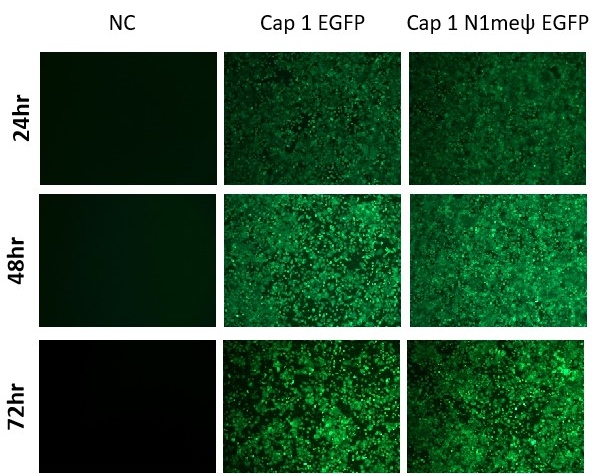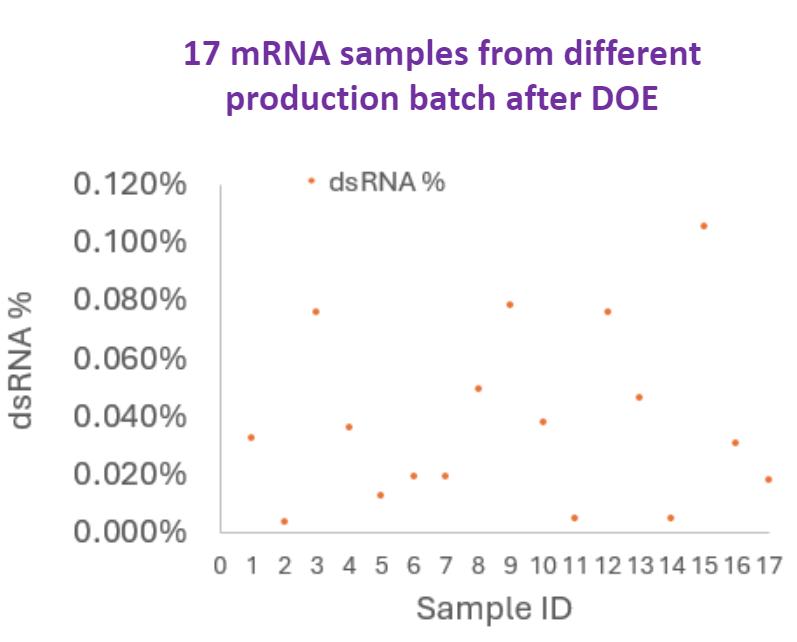PackGene offers a library of carefully designed and pre-stocked mRNA for reporter expression.
- Carefully designed and pre-stocked reporter or genome editing mRNAs designed for tracking transfection efficiency and the duration of expression in cultured cells or in vivo.
- Ready for translation mRNA are fully processed, capped, and polyadenylated.
- Pre-stocked mRNA are prefect for testing cell lines or animal models.
- LNP sampler kits are available to help determine the LNP formulation that best suits your specific needs. LNP sampler kits are available with either EGFP or Firefly luciferase reporter mRNA.
- Ready to ship in 1-3 business days for in-stock products.
- Custom mRNA with or without LNP from RUO to GMP are also available upon request.
PackGene provides ready-to-use mRNA for the expression of reporter proteins. These mRNA have been carefully designed and are readily available for monitoring transfection efficiency and expression duration in cultured cells or in vivo. Our ready-to-use mRNAs closely resemble fully processed, capped, and polyadenylated mRNAs and are,poised for translation by the ribosome.
All of our reporter gene mRNAs are offered with modified with N1-methyl-pseudo Uridine to mitigate innate immune responses. Some reporter gene mRNA are also offered with an unmodified base. These catalog mRNAs are offered in in single experiment or bulk quantities for convenience.
In stock mRNAs are ready to ship in 1-3 business days.
EGFP (Cap1, N1meψ)
EGFP (Cap 1, unmodified)
mCherry (Cap1, N1meψ)
mCherry (Cap1, unmodified)
tdTomato (Cap1, N1meψ)
Firefly Luciferase (Cap1, N1meψ)
Firefly Luciferase (Cap1, unmodified)
Renilla Luciferase (Cap1, N1meψ)
beta-gal (Cap1, N1meψ)
OVA (Cap1, N1meψ)
EPO (Cap1, N1meψ)
In stock LNP sample kits are ready to ship in 1-3 business days.
| Gene name | LNP | SKU | |
| EGFP (Cap1) | DLin-MC3 | LNPGFP001 | More |
| ALC-0315 | LNPGFP002 | More | |
| SM-102 | LNPGFP003 | More | |
| LP01 | LNPGFP004 | More | |
| formulation 1-4 | LNPGFP000 | More | |
| EGFP (Cap1, N1meψ) | DLin-MC3 | LNPMGFP001 | More |
| ALC-0315 | LNPMGFP002 | More | |
| SM-102 | LNPMGFP003 | More | |
| LP01 | LNPMGFP004 | More | |
| formulation 1-4 | LNPMGFP000 | More | |
| Fluc (Cap1) | DLin-MC3 | LNPLUC001 | More |
| ALC-0315 | LNPLUC002 | More | |
| SM-102 | LNPLUC003 | More | |
| LP01 | LNPLUC004 | More | |
| formulation 1-4 | LNPLUC000 | More | |
| Fluc (Cap1, N1meψ) | DLin-MC3 | LNPMLUC001 | More |
| ALC-0315 | LNPMLUC002 | More | |
| SM-102 | LNPMLUC003 | More | |
| LP01 | LNPMLUC004 | More | |
| formulation 1-4 | LNPMLUC000 | More | |
| Empty | DLin-MC3 | LNPE001 | More |
| ALC-0315 | LNPE002 | More | |
| SM-102 | LNPE003 | More | |
| LP01 | LNPE004 | More | |
| formulation 1-4 | LNPE000 | More |
EGFP mRNA-LNP(SM-102)
Huh7 cell line transduction

Plus, if you need a custom mRNA no matter for research or GMP production, or need assistance for testing LNP encapsulation and LNP formulation development, we’re here to help! Trust us to help you optimize your experiments and get the results you need.
What is the length range for PackGene's mRNA production?
Do you guarantee a specific yield of mRNA?
What is the concentration of your mRNA?
What is the concentration of mRNA in LNP?
How does PackGene measure residual dsRNA?
Residual double-stranded RNA (dsRNA) can form during the in vitro transcription process used to synthesize mRNA, potentially triggering unwanted immune responses in humans. To detect and quantify trace amounts of dsRNA contaminants, PackGene uses a double-antibody sandwich ELISA.
The process starts with coating the wells of an ELISA plate with a monoclonal or polyclonal antibody specific to dsRNA. When the mRNA sample is added, any dsRNA present binds to the capture antibody. After incubation, unbound material is washed away, and a second, labeled antibody—also specific to dsRNA—is introduced. This second antibody attaches to the bound dsRNA, forming a "sandwich" complex.
The detection antibody is typically linked to an enzyme, such as horseradish peroxidase (HRP), which reacts with a substrate to produce a measurable signal (colorimetric, fluorescent, or luminescent). The intensity of the signal is proportional to the dsRNA concentration and is quantified using a microplate reader, with values compared to a standard curve of known dsRNA concentrations. This highly specific and sensitive method ensures the safety and purity of mRNA therapeutics by detecting low levels of dsRNA contamination.
How is mRNA purity defined?
What is the function of N1-methyl-pseudouridine (m1Ψ) in mRNA?
N1-methyl-pseudouridine (m1Ψ) is a modified nucleoside that plays several key roles when incorporated into mRNA:
- Enhanced Stability: mRNA with m1Ψ modifications demonstrates increased stability, prolonging the half-life and allowing for longer-lasting protein expression.
- Reduced Immunogenicity: m1Ψ reduces the immune response typically triggered by unmodified mRNA, preventing inflammation and degradation, making it more efficient for therapeutic delivery.
- Improved Translation Efficiency: m1Ψ enhances translation efficiency by promoting ribosome binding and the initiation of protein synthesis, resulting in higher protein output.
- Resistance to RNA Editing Enzymes: m1Ψ provides protection against RNA editing enzymes like ADAR, which can alter the mRNA sequence by editing adenosine residues. This ensures the integrity and fidelity of the mRNA sequence during protein synthesis.
Can I use plasmids from previous vector construction orders for mRNA production?
Yes, we can subclone your ORF sequences into our proprietary vector, which includes the T7 promoter, UTR, and a 110A tail, for mRNA production.
How much mRNA is needed to transfect cell cultures?
How much mRNA in LNP is needed for mouse injections?
Does PackGene provide GMP-grade mRNA?
Yes, we can supply cGMP mRNA through our partnership with Kudo Biotechnology. For more information, please visit our GMP mRNA service webpage. Please check our GMP mRNA webpage.
